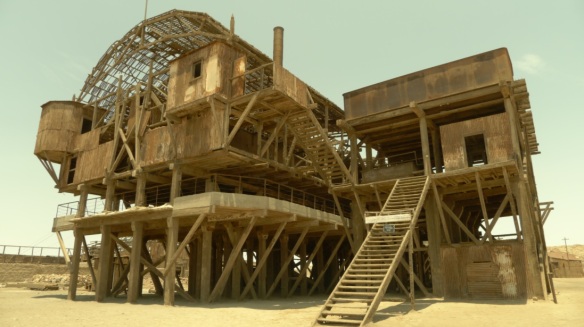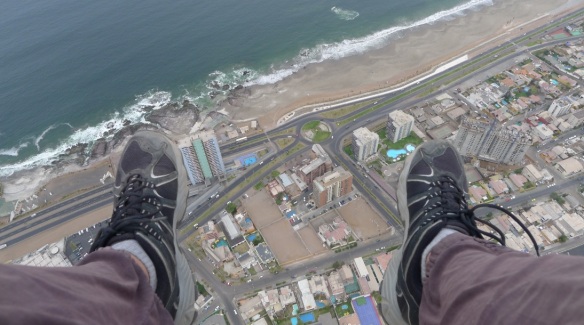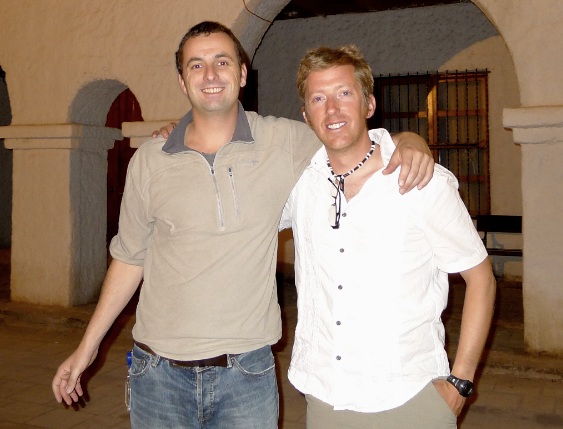Jesse: It’s been a while since our last blog post, and inevitably, the adventures and experiences pile up on a trip like this, so this post might be a long one! We left Puno and headed towards Arequipa, Peru’s second largest city. Our route took us up over the roof of the Andes again, where dark storms flurried snow on the hillsides above–and freezing rain on us (the usual)–and the altitude took our breath away. The outskirts of Arequipa were depressingly run-down, but the city core sported some lovely white-stone architecture and first world amenities. Hungry for a change from the local food, we made an impromptu stop at a T.G.I. Friday’s and ordered the sloppiest hamburgers we could find and for an hour pretended we were home again. We found a cute, family-run hostel with bike parking and then crashed in our room and watched a marathon of House on the cable TV.
The next day we felt completely refreshed and set out to explore the city. The first stop was the Museo de Artefacto Andinos, where we were shown a fascinating guided exhibit about Incan child sacrifices, culminating with the display of Juanita, the frozen remains of a 12 year old Incan princess. Apparently the Incas would sacrifice ritually-selected children once every four years (coinciding with the El Niño weather pattern) on the highest peaks in theAndes, close to the home of the gods. Juanita was particular in that she was found alone (most sacrifices were multiple) and buried in royal regalia, indicating her rank as a princess. Her remains were huddled in the darkness of a very dim, highly refrigerated glass box.
That evening we headed to the Monasterio de Santa Catalina, a 17th century convent which housed nuns selected from the upper echelons of society…After living in secluded, hedonistic style for a hundred years, they were eventually brought down from the high life by a stern nun from the outside world. The convent was enormous, spanning a full city block with gigantic, fortress-like walls on the outside and an astounding maze of brightly coloured streets, courtyards, houses and fountains, all with torches and fireplaces lit, filling the place with the scent of wood smoke and giving the impression that the nuns had just stepped out.
The next day we sped further south into the sprawling hot deserts of southern Peru. The emptiness of the land surrounded us; at one point we clocked a straight section of the highway 36 km without a curve. We reached the border of Chile in the late afternoon, and after a fairly painless crossing (which included x-raying our luggage, a first for this trip!) we arrived atArica, a pretty Caribbean-esque port town with an enormous rock bluff overhanging the town square. We spent a lazy day there, visiting Eiffel’s cast-iron church (forged in Paris and assembled in Arica) and the beautiful beaches south of the town. The water, however, was absolutely frigid, the Humboldt Current carrying Antarctica’s chilly waters northward. Moreover, it was filled with jellyfish, so we didn’t swim so much as stand in the waves and gasp every time we were hit. That night was New Years Eve. The shops closed at 5:00 PM and Arica became a ghost town until midnight when fireworks lit up the sky above the rocky bluff and revellers entered the town square for a giant salsa dance. We danced to a few tunes, saw a couple UFOs (we think they were paper lanterns propelled aloft by an internal flame, but we couldn’t be sure—so they remain unidentified!) and hit the hay by 1:00 AM.
New Years Day, we hit the long road from Arica to Iquique (pronounced e-key-kay). The road wound up and down through desert valleys and through the northern plain of the Atacama dessert (the driest in the world) where dust devils spun on the horizon like giant twirling dervishes. Just beforeIquique, we crested an enormous sand dune and began a long switchbacked descent towards the city, which rested on the narrow coastal plain below. The city was a pretty, modern beach town with the downtown core populated with the old-west architecture from the Nitrate-mining heydays of the late 1800s. Our first day there was spent exploring the UNESCO world heritage site of Humberstone, an old nitrate-mining town and neighbouring mine that was abandoned en-mass with the advent of artificial fertilizers in the 1960s. The mine itself was set out on the broiling plain of the Atacama and Jess and I had a great time exploring the skeletons of the huge old buildings—virtually without another tourist there. The town of Humberstone was much more touristy, with many of the buildings set up as museum pieces. Towards the outskirts in the back, however, the town became deliciously creepy and we explored to our hearts content for the entire afternoon.
The next day I decided to take advantage ofIquique’s unique position as the paragliding capital of the world, and go for a little flight. We contacted a Lonely-planet recommended company, and they picked Jess and I up from the hostel and drove us to the top of the giant mountain/sand dune overlooking the city. After a quick safety briefing, I was buckled into Raul, the Chilean champion of acrobatic gliding, and seconds later the wind pulled us firmly skyward. The sensation of flying in the open, with only the sound of the wind and the distant noise from the world below, was incredible. We soared up to 3000 ft, and headed out over the city. The conditions were perfect and we cruised smoothly beneath the clouds. Moments before our touchdown on the beach, I asked Raul to give me a little demo of his acrobatics, so we executed a few hair-pin turns which jumped our velocity from a happy 35 km/h to blazing 150 km/h in the span of 3 seconds. Fantastic fun, but the last few seconds made me incredibly airsick. Ah well, it was completely worth it. That night Jess and I stopped by an old-west photography studio and got a shot of us dressed as a dandy and lady of high Chilean society, circa 1920.
Our next stop was San Pedro de Atacama, high up on the bulge of the Andean foothills. We were there to meet up with Rogier and Anna, our Dutch friends that we had met on the sailboat crossing from Panama to Columbia. We had arranged to go on a 4×4 tour of southern Bolivia with them, as we had mutually decided to not motorcycle that particular country, given its notorious lack of anything resembling a good road. San Pedro de Atacama was something of a dusty hole which, due to its location next to some amazing natural wonders, had become a serious tourist trap complete with surely locals and massively inflated prices. While we waited for Rogier and Anna to arrive, we explored what little of the town was worth exploring and pondered how we were going to eat for a reasonable price.
Our tour embarked a little late, and once we reached the Chilean side of the border, we found out why. The Chilean side is situated at a comfy 2800 m, while the remote Bolivian office was high up on the Andean plateau at 4200 m where the roads had been closed from snow for the past two days. While we waited at the border with hordes of other tourists (most of whom were headed to Argentina, whose border was also shut), the information changed every 10 minutes: no, the border was closed indefinitely; yes, it would open in 30 minutes, be patient; no, the tour would be cancelled and we’d try tomorrow; yes! The border was open; no, that was a lie, it was still closed. Finally, after waiting 5 hours, the border was indeed finally open and we were stamped out of Chile.
The Bolivian border is indeed remote: it is 47 km away from the nearest town, high up on a barren saddle between two picturesque volcanoes. There we switched to Bolivian 4x4s and Bolivian drivers and set off in a convoy of jeeps into the astounding landscape that is southern Bolivia. We first visited Laguna Blanca and Verde, the White and Green Lakes, colored by mineral deposits from the surrounding mineral-laden volcanoes. We then drove through high altitude desert valleys, our drivers finding their own way through the rocky landscape more often then following the rough track of a road. We stayed the night at a mud-brick refuge on the shores of Laguna Colorada, the famous Red Lake. The next day we explored the shores of the lake…the warm, shallow water was an opaque orangey-red, and filled with colourful flamingos who stalked back and forth, searching for tiny plants and animals in the silt of the lake bottom. From there we headed out to the Arbol de Piedra, the Tree of Stone. It was a garden of rocks that had been carved by wind erosion into fantastic shapes, including the rock shaped vaguely like a tree. I had a blast climbing as many of the towering rock formations as I could in the time we had.
The altitude took its toll on our little group. We suffered all the usual symptoms: massive dehydration headaches, frequent urination, sleep apnea, difficulty breathing—and group-wide constipation! Moreover, the tour company was highly mediocre with uninformed guides, poor food, and, on the last night, no drinks with our meal (but they would SELL us drinks!) Still, we had a ton of fun and saw some amazing sights. Near Uyuni we visited the famous train graveyard for a few quick pictures, and then headed out to the highlight of the trip: the Salar de Uyuni, the largest salt flat in the world. Although crowded with other jeeps and hordes of tourists, the Salar was an otherworldly experience. It was the wet season, so the salty surface was covered by several centimetres of water, creating an incredible mirror-like effect such that, when looking at the horizon, it was hard to tell where the Salar ended and the sky began. Moreover, although storms raged all around us, the sky was perfectly clear above the Salar: the salt had sucked all the moisture out of the sky. We took some fun perspective photos on the Salar, and then, all too soon, started our long trip back to San Pedro.
We arrived back in town the following day, and signed up for a late afternoon tour to watch the sunset over the Moon Valley. It was a great tour with an informative guide and another dose of other-worldly landscapes and narrow gorges to explore. The valley was magnificent, the sunset a little watery. That night Jess and I met up with my old friend Jeff from my UVic days. We had been room mates during our co-op job in Hawaii, but had lost touch after our undergrad degrees. Jeff was now working as an astronomer at the ALMA radio telescope in the Atacama desert. We had a great meal with Jeff and a few of his colleagues, caught up on our lives for the past 10 years, and reminisced about the good old days.
From San Pedro we again turned south and began our long, hard ride towards the end of the continent. We have a month and a half left, and over 6000 km to cover…
































